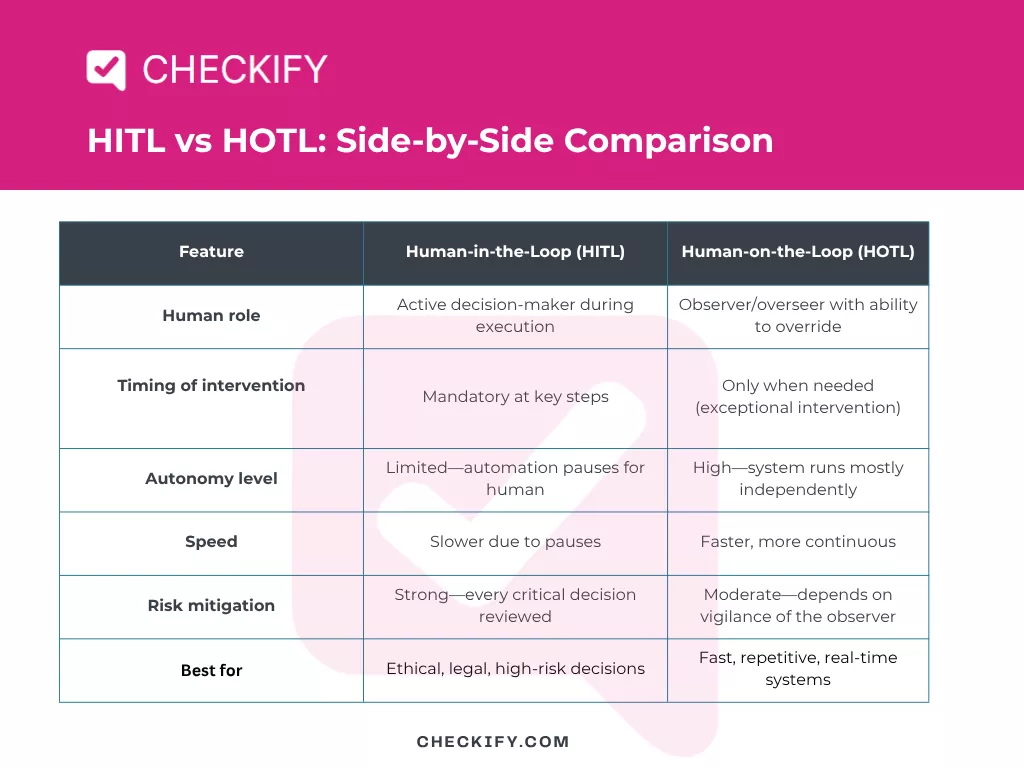
As automation and AI systems become increasingly embedded in decision-making, there is an increasing debate about how humans should be involved. Should we directly participate in every decision? Or should we oversee the system from a distance, ready to intervene if something goes wrong?
That’s where the terms Human-in-the-Loop (HITL) and Human-on-the-Loop (HOTL) come in. They describe two distinct models of human oversight, and understanding the distinction is crucial for designing ethical, effective, and safe systems.
What Is Human-in-the-Loop (HITL)?
HITL refers to a setup where humans are directly involved in decision-making during the operation of an automated system. The process cannot continue until a human takes action—whether to approve, correct, or reject what the machine has proposed.
Example:
- A loan processing system reviews an application and flags it as borderline.
- A human analyst must approve or deny the loan before the system proceeds.
- The human is literally “in the loop.”
Where it’s used:
- Fraud detection
- Medical diagnostics
- Customer service escalation
- Document review
- AI model training (e.g., data labelling or low-confidence results)
What Is Human-on-the-Loop (HOTL)?
HOTL refers to a setup where a human oversees an automated process from above, often passively, and only intervenes when necessary. The system operates autonomously but includes mechanisms for human override or monitoring.
Example:
- An autonomous drone navigates on its own.
- A human operator watches from a control centre and can intervene if it veers off course or encounters danger.
- The human is “on” the loop, not in it.
Where it’s used:
- Military defence systems
- Autonomous vehicles
- Industrial automation
- AI-based surveillance
- High-frequency trading platforms
HITL vs HOTL: Side-by-Side Comparison

When to Use HITL vs HOTL
Choosing between HITL and HOTL depends on risk, speed, and context.
Use HITL when:
- Decisions carry legal or ethical consequences
- You need accountability and traceability
- The AI system has low confidence or incomplete data
- Compliance with regulation (e.g., GDPR, HIPAA) requires human judgment
Example: In healthcare, AI may assist in diagnosing, but a doctor must confirm the diagnosis and approve treatment. That’s HITL.
Use HOTL when:
- You need fast, continuous, or real-time operation
- The system is highly reliable, but intervention is still required in rare cases
- Human input is valuable, but shouldn’t slow the system down
Example: In military drone operations, HOTL allows rapid autonomous behaviour with a human ready to intervene if something unexpected happens.
Real-World Examples of HITL and HOTL
Healthcare
- HITL: An AI flags a potential tumour in a scan. A radiologist reviews the image before diagnosis.
- HOTL: A real-time heart rate monitoring system alerts a doctor only when readings fall outside safe parameters.
Military
- HITL: A target recognition system suggests potential threats, but human operators must approve engagement.
- HOTL: Autonomous surveillance drones fly missions, with human oversight via control systems.
Finance & Fintech
- HITL: An AI fraud detection system flags a suspicious transaction. A human analyst reviews the account before it is frozen.
- HOTL: Algorithmic trading systems run in real time. A trader monitors the dashboard, intervening only if anomalies occur.
Difference Human-in-the-Loop (HITL) and Human-on-the-Loop (HOTL)
Human-in-the-Loop (HITL) and Human-on-the-Loop (HOTL) are two powerful oversight models—and knowing the difference is key to building responsible automation.
- Use HITL when you need judgment, ethics, or accountability
- Use HOTL when you need speed, scale, and reactive oversight
The goal isn’t to remove humans from automation—it’s to put them in the right place at the right time.
AI refers to computer systems that can perform tasks normally requiring human intelligence, such as learning, problem-solving, and decision-making.
AI helps automate repetitive tasks, identify workflow bottlenecks, make real-time decisions, and optimise operations for greater efficiency and accuracy.
Automation follows predefined rules to perform tasks, while AI can learn from data, adapt to new inputs, and make independent decisions.
Machine Learning is a type of AI that enables systems to learn from data and improve their performance over time without being explicitly programmed.
AI often augments human work rather than replacing it, handling repetitive tasks so people can focus on creative, strategic, or high-value work.
AI boosts productivity by reducing manual work, speeding up processes, improving accuracy, and enabling smarter decision-making across workflows.